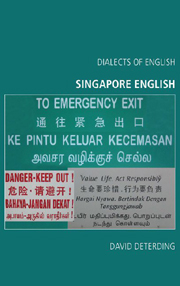2 - Phonetics and Phonology
Published online by Cambridge University Press: 12 September 2012
Summary
In this chapter, first the consonants and then the vowels of Singapore English will be discussed before we consider suprasegmental features such as rhythm, intonation and stress placement. We will also attempt to compare the sounds of Singapore English with the English found in other countries in the region.
It is important to describe the phonology of each variety of a language on its own terms, without reference to external norms and preconceived notions of how certain words ‘should’ be pronounced. To this end, we will discuss the vowels of Singapore English by means of the lexical keywords suggested by Wells (1982) and listed in Table 2.1.
Following Wee (2004a), an extra keyword poor is adopted, as in Singapore the vowel in poor, sure and tour is different from that in cure and pure. We will consider issues such as this, as well as mergers like that between fleece and kit and also the quality of the vowel in face and goat, later in this chapter.
It is important to establish that, in this chapter and elsewhere, we are often talking about tendencies, not absolutes. Many of the features that are discussed are ones that sometimes occur, but there is no suggestion that they are always found, even with data from one speaker recorded on a single occasion. For example, if we say that final pronouns tend to be stressed, we do not claim that they are always stressed, just that they are stressed more often than might be expected in many other varieties of English.
- Type
- Chapter
- Information
- Singapore English , pp. 12 - 39Publisher: Edinburgh University PressPrint publication year: 2007



